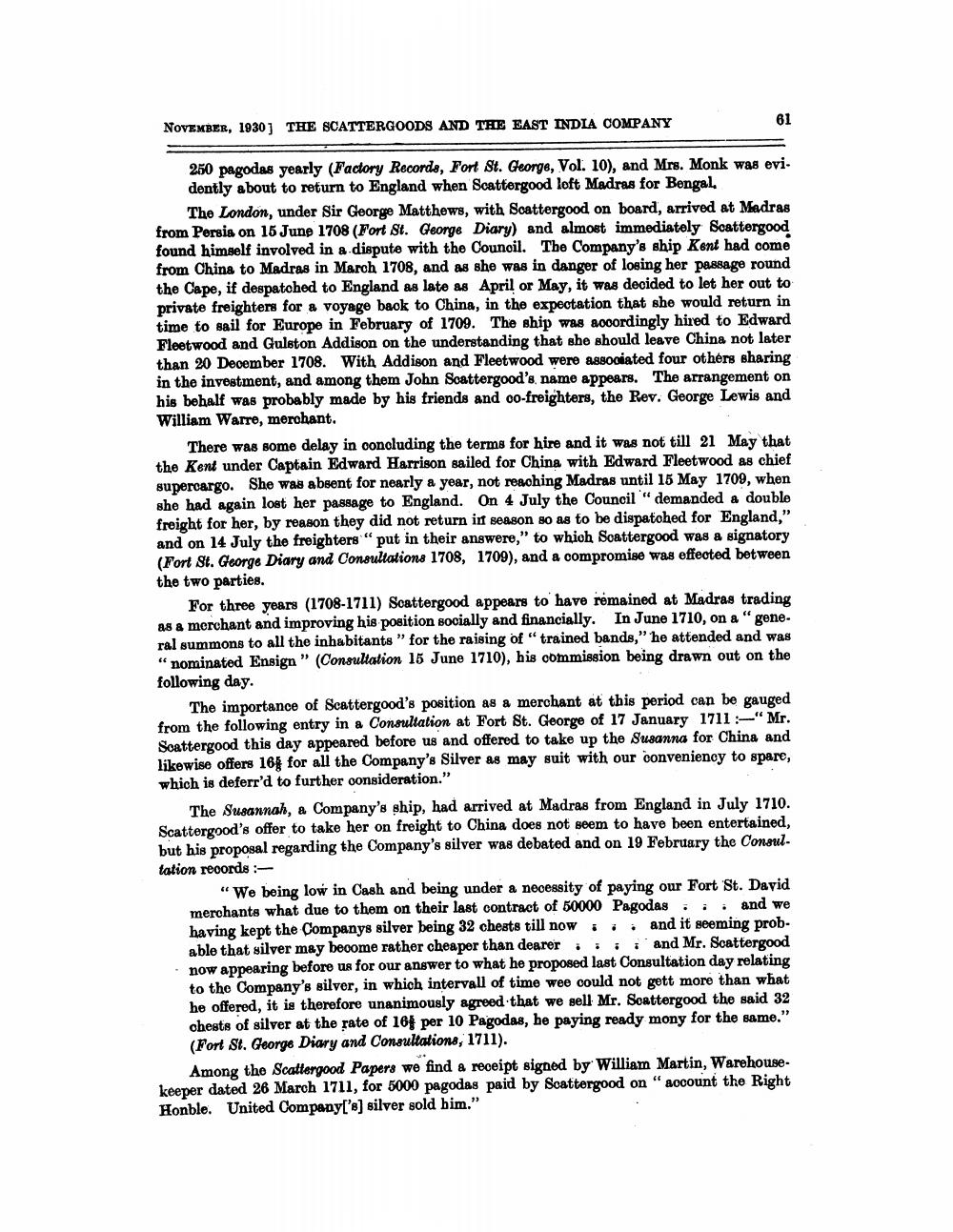________________
NOVEMBER, 1930) THE SCATTERGOODS AND THE EAST INDIA COMPANY
61
250 pagodas yearly (Factory Records, Fort St. George, Vol. 10), and Mrs. Monk was evidently about to return to England when Scattergood loft Madras for Bengal,
The London, under Sir George Matthews, with Scattergood on board, arrived at Madras from Persis on 15 June 1708 (Fort St. George Diary) and almost immediately Scattergood found himself involved in a dispute with the Council. The Company's ship Kent had come from China to Madras in March 1708, and as she was in danger of losing her passage round the Cape, if despatched to England as late as April or May, it was decided to let her out to private freighters for a voyage baok to China, in the expectation that she would return in time to sail for Europe in February of 1709. The ship was accordingly hired to Edward Fleetwood and Gulston Addison on the understanding that she should leave China not later than 20 December 1708. With Addison and Fleetwood were associated four others sharing in the investment, and among them John Soattergood's name appears. The arrangement on his behalf was probably made by his friends and co-freighters, the Rev. George Lewis and William Warre, merchant.
There was some delay in oonoluding the terms for hire and it was not till 21 May that the Kent under Captain Edward Harrison sailed for China with Edward Fleetwood as chief supercargo. She was absent for nearly a year, not reaching Madras until 15 May 1709, when she had again lost her passage to England. On 4 July the Council" demanded a double freight for her, by reason they did not return irf season so as to be dispatohed for England," and on 14 July the freighters" put in their answere," to which Soattergood was a signatory (Fort St. George Diary and Consultations 1708, 1709), and a compromise was effected between the two parties.
For three years (1708-1711) Scattergood appears to have remained at Madras trading as a merchant and improving his position socially and financially. In June 1710, on a "gene. ral summons to all the inhabitants " for the raising of "trained bands," he attended and was " nominated Ensign " (Consultation 15 June 1710), his commission being drawn out on the following day.
The importance of Scattergood's position as a merchant at this period can be gauged from the following entry in a Consultation at Fort St. George of 17 January 1711 "Mr. Soattergood this day appeared before us and offered to take up the Susanna for China and likewise offers 164 for all the Company's Silver as may suit with our conveniency to spare, which is deferr'd to further consideration.”
The Susannah, a Company's ship, had arrived at Madras from England in July 1710. Scattergood's offer to take her on freight to China does not seem to have been entertained, but his proposal regarding the Company's silver was debated and on 19 February the Consul. tation records
"We being low in Cash and being under a necessity of paying our Fort St. David merchants what due to them on their last contract of 50000 Pagodasi and we having kept the Companys silver being 32 cheats till now i and it seeming probable that silver may beoome rather cheaper than dearer i
and Mr. Scattergood • now appearing before us for our answer to what he proposed last Consultation day relating
to the Company's silver, in which intervall of time wee could not gett more than what be offered, it is therefore unanimously agreed that we sell Mr. Soattergood the said 32 chests of silver at the rate of 164 per 10 Pagodas, he paying ready mony for the same." (Fort St. George Diary and Consultations, 1711).
Among the Scattergood Papers we find a receipt signed by William Martin, Warehousekeeper dated 26 March 1711, for 5000 pagodas paid by Soattergood on "account the Right Honble. United Company['e] silver sold him."




